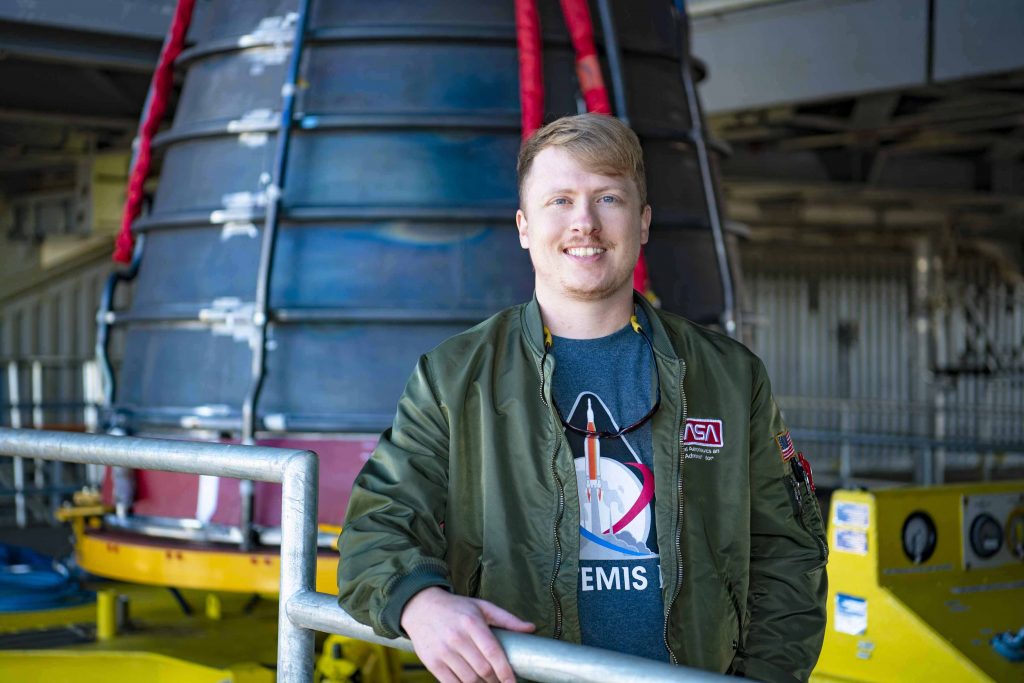NASA Engineer Finds Sweet Spot at NASA Stennis
January 18, 2023

Bradley Tyree: NASA engineer Bradley Tyree supports testing of the RS-25 engine, pictured in the background, at the Fred Haise Test Stand at NASA Stennis. Four RS-25 engines help power NASA’s Space Launch System rocket. Photo Credit: (NASA/Danny Nowlin)
The challenge, excitement, and reward of helping to return humans safely to the Moon is what inspires NASA engineer Bradley Tyree daily at NASA’s Stennis Space Center. It is at NASA Stennis where Tyree’s talents meet a mission greater than himself as NASA explores the secrets of the universe for the benefit of all.
“They say when you enjoy what you do, then you will never work a day in your life, and I believe that is true,” Tyree said. “I look forward to coming in every day because each day offers a new challenge, whether it’s building up a new system or meeting the ever-changing test requirements of the RS-25 or improving a system that has been installed for years by implementing a new technology and using existing alternate industry practices.”
The Carriere, Mississippi, native and current Picayune resident comes from multiple generations local to the area near NASA Stennis, so Tyree wanted to return after earning a bachelor’s degree in aerospace engineering at Mississippi State University in 2018. A conversation with his college roommate alerted Tyree that NASA Stennis was hiring. Tyree recalls eagerly submitting his application, and after a competitive interview experience, he was offered a job in the E Test Complex working in test operations for Syncom Space Services.
Tyree accepted a position with NASA’s mechanical test operations team in 2020, where he supports the RS-25 program at the Fred Haise Test Stand. Tyree helps maintain and operate the various mechanical systems needed to conduct RS-25 tests, including those for delivering propellants. The NASA engineer supported Green Run testing of the Space Launch System (SLS) core stage on the B-2 Test Stand by operating helium compressors staged at the E-3 Test Stand. The compressors helped provide helium gas required to purge and maintain the liquid hydrogen run tank on the core stage.
Following the launch of Artemis I, Tyree is curious to see how NASA implements what it has learned from both Green Run testing and the actual launch of the SLS rocket.
Tyree is implementing new skills learned through working alongside veteran engineers at NASA Stennis. In 2022, he completed work for his liquid hydrogen transfer qualification.
He now is working toward a similar qualification for the liquid oxygen transfer role before pursuing qualifications to become a test conductor.
“What I find interesting about the NASA Stennis culture is there are a number of personnel who have been working on the stands and testing rocket engines for longer than I have been alive,” Tyree said. “It is an amazing opportunity to work alongside some of these knowledgeable engineers and technicians who have an in-depth understanding of how their individual work plays a part in the entire process of testing engines.”
In the world of test operations, various challenges present themselves. Tyree embraces the greatest challenges, which to him are those that are not expected. He credits the team at NASA Stennis for how it identifies solutions to challenges in real time.
“I’m proudest to be a part of the same group of engineers that I looked up to as a child,” Tyree said. “What I once thought was only a dream has become a reality, and I want to do the best I can to try and be a good team member, role model, and knowledgeable engineer that will inspire the next generation of thinkers.”
For information about Stennis Space Center, visit: www.nasa.gov/centers/stennis/
Lacy Thompson
Stennis Space Center, Bay St. Louis, Mississippi
NASA’s Stennis Space Center, located near Bay St. Louis, Mississippi, is a federal city operated by NASA since 1961. As many as 40 onsite agencies, organizations, universities, and companies share operating costs, while pursuing individual missions, as a model of fiscal efficiency. If their combined workforces of about 5,000 employees were counted as a single entity, Stennis would rank among the Top 10 Mississippi companies in size. The site is a major economic engine for the Gulf Coast region, with an average direct annual impact of more than $625 million within a 50-mile radius.
Category: Alumni, ASE, News, Newsroom, Recognition
